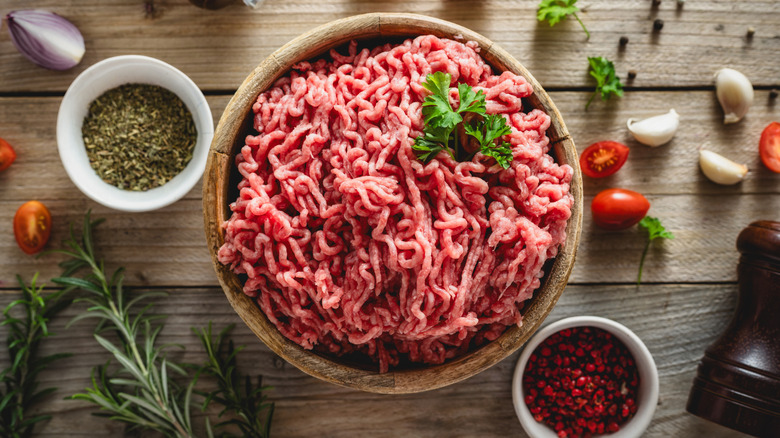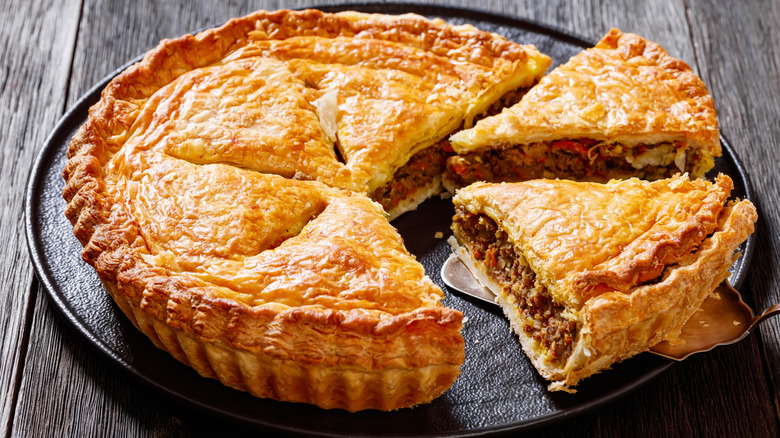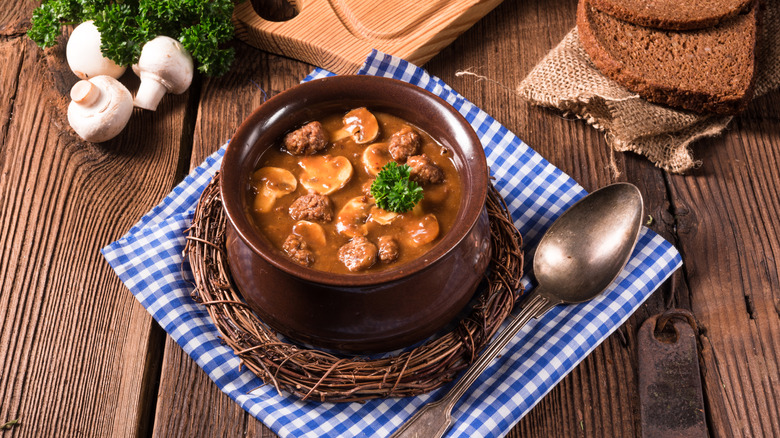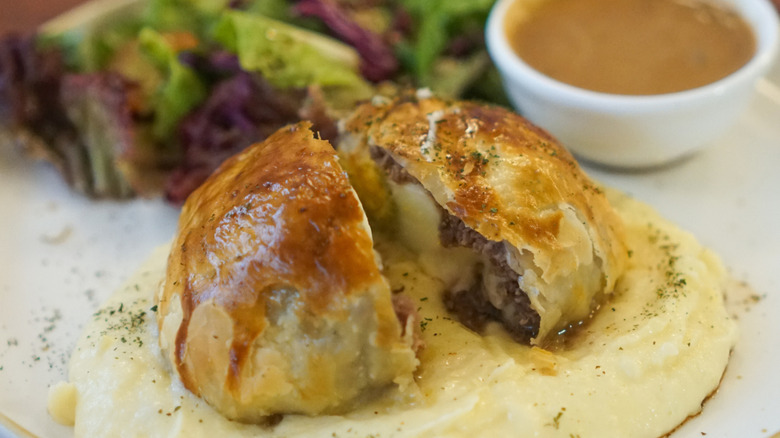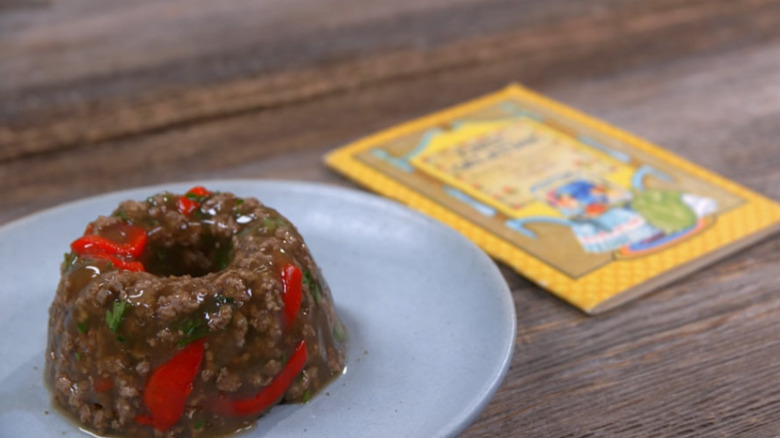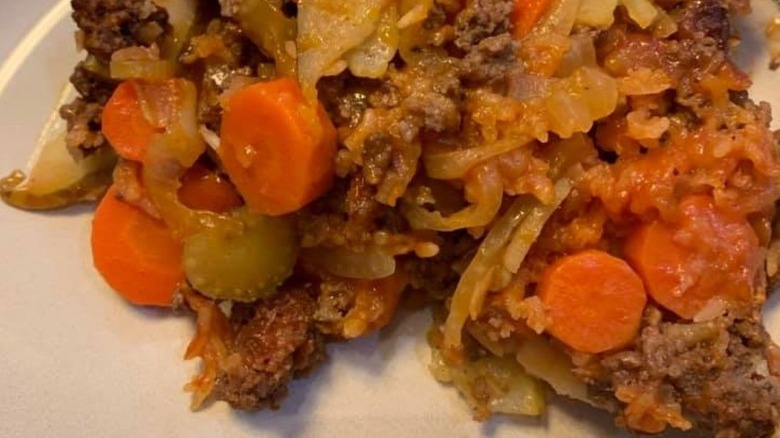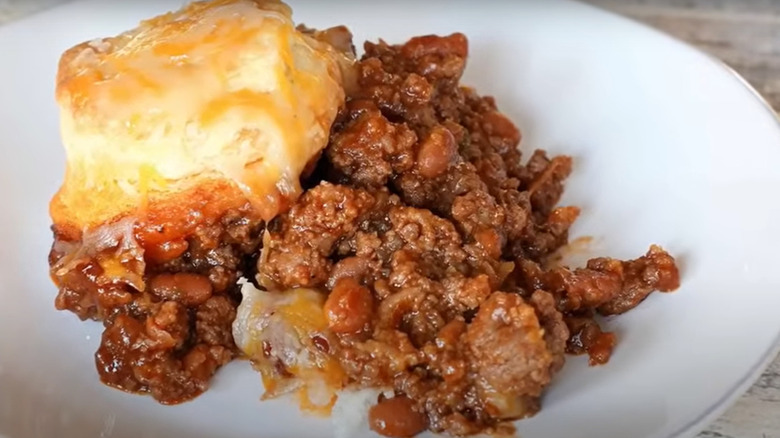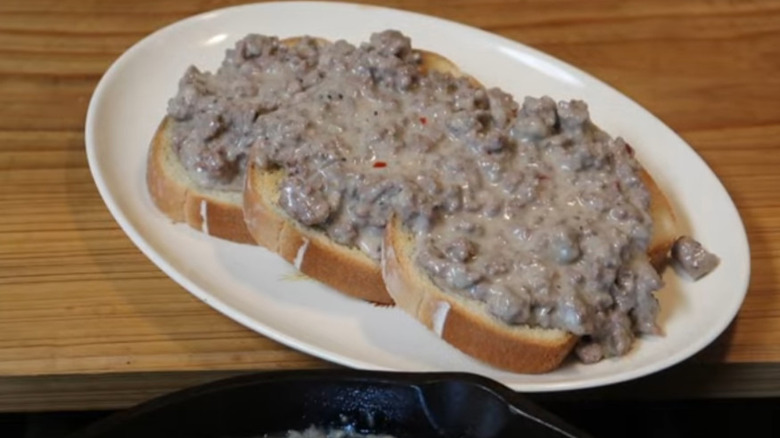Vintage Ground Beef Dishes You Don't See People Eating Today
Ground beef became a fundamental ingredient in American home cooking during the 19th century through hamburgers which gained popularity as home meat grinders became common and industrial food processing developed. The Great Depression era made some ground beef recipes extremely popular because they were affordable and versatile with high protein content. Although some of these vintage dishes provide valuable insights into American food history because they demonstrate how families managed with limited resources while trying new culinary approaches, others give us a closer look at the creativity of home cooks who experimented with new and unconventional recipes of their time.
Ground beef was a great option because of its texture and adaptability so it could be used for a wide range of dishes from casseroles and patties to stuffed vegetables and savory pies. It also cooks very easily and quickly, which makes it a go-to protein for busy parents. While many of these ground beef recipes were at one time commonplace on dinner tables, they've mostly disappeared from modern cuisine for various reasons. Though these dishes may not return to popularity, they demonstrate the creative ways people cooked during past times.
Beef fudge
A cookbook from1967 written by wives of Polled Hereford cattle farmers from all over the world features a recipe for beef fudge which combines ground beef with chocolate fudge to create a sweet-savory treat that delivers protein-rich indulgence. They prepared this dish by combining butter or margarine with evaporated milk, sugar, chocolate chips, marshmallow cream, vanilla extract, ground roast beef (but of course), and chopped walnuts. We know it might seem like an odd combination of ingredients today, but beef fudge represents an experimental era in American home cooking. It was most likely very popular in rural or meat-producing communities but it didn't become a global hit because of the unique combination of flavors.
Today, beef fudge exists mostly in vintage cookbooks and food blogs that study historical culinary curiosities. This recipe quite nicely shows us how home cooks in olden days transformed excess ingredients such as ground beef into new culinary creations. The recipe demonstrates the mid-century American interest in kitchen innovation because it appeared in community cookbooks instead of mass-market publications. Traditional chocolate fudge has maintained its popularity,but beef fudge failed to sustain itself, likely because of its unusual taste and restricted consumer base. The existence of this recipe provides valuable insights into the culinary creativity of its era.
Hamburger upside down pie
The highlight of this casserole is biscuit topping baked crust over savory beef and vegetable filling. The dish consisted of ground beef, tomato sauce, green pepper, cream of mushroom soup, and biscuit dough which made it a hearty and satisfying weeknight dinner, right at home in the mid-20th century United States. The pie gained popularity because of how it could be prepared in one pan which suited families who had limited kitchen space and few resources for washing dishes. Some cookbooks of the era popularized this recipe because of how it promoted efficient and innovative home cooking methods.
While the real reason behind why hamburger upside down pie disappeared from regular household meals is not really known, it could be that the shift toward eating lighter meals with fresh ingredients and international cuisine patterns contributed to its disappearance from popular diets. Also, the evolution of food technology brought pre-packaged and frozen meals which became easier alternatives to homemade casserole dishes thus reducing their necessity. Luckily for us, the original concept of hamburger upside down pie continues to live on through contemporary comfort foods including shepherd's pie, sloppy joe casseroles, and skillet biscuit bakes.
Mock turtle soup
The economical version of turtle soup known as mock turtle soup was a creative stand-in for the once-fashionable green turtle soup, which had been considered a delicacy in upper-class European and American dining. Its preparation involved cooking ground beef with celery, onions, garlic, tomato paste, Worcestershire sauce, fresh thyme and hard-boiled eggs in a sherry-infused broth. The eggs stand in place of turtle meat, and the sherry brought a touch of sophistication to a dish otherwise made from ordinary ingredients. The creative mixture succeeded in delivering a replica of a luxurious dining experience at an affordable price without requiring expensive or hard-to-find ingredients, thus making it accessible to ordinary families.
As a result, during the 18th and 19th centuries, people created mock turtle soup as a budget-friendly alternative to green turtle soup which was both expensive and hard to obtain. Ground beef became a staple in this recipe during the Great Depression when people substituted it for expensive or hard-to-find organ meats and luxurious cuts of meat. The addition of sherry and hard-boiled eggs created a more complex flavor profile that closely matched the original dish. Although this dish disappeared from modern kitchens, it shows how scarcity, changing tastes, and traditional practices influenced culinary development.
Depression-era meatloaf wellington
This recipe was a much thriftier take on beef wellington, which included wrapping meatloaf in pastry for a touch of elegance. Home cooks from back in the day replaced expensive beef tenderloin with a seasoned ground beef meatloaf which they baked before placing it inside a pre-made pastry shell. Frozen patty shells served as the foundation for this dish because they created a beautiful golden flaky crust without requiring pastry expertise or additional ingredients. The combination of liver spread with breadcrumbs and olives served as flavor enhancers while adding bulk to transform an ordinary protein into a sophisticated dish.
This version of wellington appeared at special occasions such as holidays and social events because hosts needed to create impressive meals without exhausting their pantry supplies. It was also a dish that was much faster to prepare — an hour and a half at most — compared to the original beef wellington that required many hours of preparation.
However, the need for it slowly disappeared when economic conditions improved and premium cuts of meat became more accessible. Though it has never made a full resurgence to popularity, it did gain some traction a few years ago when Chrissy Tiegen posted about making it on her Instagram.
Beef stretcher patties
The Great Depression led to the creation of stretcher patties' which were tasty patties made from oats, bread or vegetables to extend small amounts of ground beef into more servings for struggling families. The most basic recipes consisted of ground beef combined with chopped onions and rolled oats and milk. The patties received excellent seasoning to mask any differences in taste. There wasn't a one-size-fits-all recipe for this one as home cooks would basically use whatever they had in their pantries to make it work. Additions like rice were also great because it absorbed all the ground beef juices which created a flavorful effect that trapped the flavors inside the patties. The home cooks adjusted their seasonings according to personal taste but carrots and onions proved to be very useful for expanding the patty size.
Well, tough times did not last forever and as a result, the popularity of stretcher patties declined as people gained better access to affordable meat and convenience foods became more common. The recipes spread through community cookbooks and handwritten notes during a period when cooking required both necessity and creativity. Stretcher patties have largely faded from modern cooking but the dish and other budget-friendly burgers, like the Depression-era Mississippi Slugburger, serve as a reminder of a time in U.S. history when making ends meet meant resourcefulness in the kitchen.
Beef Jell-O mold
During a time when molded foods became symbols of culinary advancement and domestic refinement, several gelatin-based meat dishes including beef Jell-O appeared. The dish consisted of ground beef cooked with broth and gelatin which was molded into decorative shapes before serving chilled at social events. The recipes appeared in cookbooks and homemaking magazinesand were meant to appeal to housewives short on time, but needing meal that was cooked fresh. Limited refrigeration options and tight budgets made molded meals attractive because they minimized prep while adding visual appeal.
The flavor of this dish is much more appealing if you throw in some vegetables, lemon juice, and Worcestershire sauce, while parsley and pimentos will add a visual appeal. The appreciation of savory gelatin molds depended on a particular cultural atmosphere that had not yet dismissed this food trend. As culinary trends shifted toward even easier prep with the microwave, meat-based gelatin molds began to seem less convenient and in the case of beef Jell-O, unappetizing. Beef Jell-O exists today primarily as a historical artifact which appears in retro cookbooks and nostalgic blogs.
Porcupine meatballs
The uniquely-named dish consisted of rice-filled meatballs cooked in a tomato sauce while retaining their rice grains which resembled porcupine quills. The meatballs gained widespread popularity among American families during the 1940s through 1950s. While there are numerous mouthwatering meatball recipes, porcupine meatballs stood out for their ability to stretch ground beef with rice, making them a frugal yet flavorful option during lean times. The recipe contained only fundamental ingredients such as ground beef, rice, onions and pepper which fit within most household budgets. The secret to this dish involved adding uncooked rice to the mixture so the rice would protrude from the meatballs after baking.
It was also a relatively easy recipe, designed for simplicity and waste reduction. Whether cooked in the oven or on the stove top, the end result was a simple dish that could feed a family. Porcupine meatballs never achieved the popularity of other ground beef dishes like meatloaf or sloppy joes. You're most likely to find the recipe in a vintage cookbook or online archive, highlighted because of its unusual name and its practical origins, rather than any remaining nostalgic value.
Hamburger poppy-seed turnovers
Hamburger poppy-seed turnovers consisted of a very flaky crescent dough that was stuffed with ground beef, onions, and cheese, then topped with poppy seeds. They were more of a savory twist on hand pies. Some much simpler recipes for it used flour, seeds, cold water, and poppy seeds for the pastry, while minced onion, shortening, ground beef, salt, pepper, MSG (which is optional really), and condensed cream of mushroom soup for the filling.
This recipe made sense and was functional for families in its time because the turnovers could be prepared in advance through batch production and freezing for reheating later. Also, the convenient hand size of these turnovers made them quite suitable for school lunches and casual dinners or quick snacks while on the move. They were also versatile –- variations allowed for added ingredients like shredded cheese or different spices to suit household tastes. Adding an egg wash to the edges. which were sealed by pinching them with a fork, would add a beautiful golden finish for visual appeal. The good news is, rather than fading entirely, some elements of this dish live on in today's freezer-aisle pastries and lunchbox snacks -– proof that the core idea of convenience wrapped in dough didn't go out of style.
Shipwreck casserole
The Shipwreck Casserole was a layered one-dish wonder that combined ground beef, kidney beans, potatoes, rice, buttered corn flakes, and tomato soup. During its time, it was probably one of the best casseroles to make for dinner. The inspiration behind the name of this dish is said to have come from times when soldiers would quickly gather scraps of whatever food they could find after a shipwreck and would go on to make a meal from the food. That's why the casserole has such an odd combination of ingredients. However, the legend is unverified and the true meaning behind the name remains a mystery. The recipe was also very easy to make and would involve layering each ingredient in a casserole dish and pouring tomato soup all over it before adding the next ingredient on top, and then baking it until the potatoes were done. Simple and straightforward.
Each layer served a purpose really. Potatoes for heartiness, ground beef for protein, rice for bulk, and beans for extra fiber and texture. The final touch — which was usually crushed, buttered corn flakes — added a crispy contrast to the otherwise soft layers below. This recipe can also be made using chopped onions and carrots for added variety. The condensed tomato soup functioned as both a binding agent and a flavor enhancer which eliminated the requirement for complex seasonings or extra sauces.
Ground beef grand style
Ground beef grand style was a mid-century casserole that aimed to dress up humble ingredients with a touch of flair. The dish became popular not long after refrigerated biscuits hit shelves and because it used ground beef with cream cheese and mushroom or chicken soup and other pantry staples like catsup, and stuffed olives to create a dish that seemed more expensive than its ingredients. It had a beautiful presentation of golden biscuits around the edge and optional stuffed olives on top created an illusion of gourmet quality, although the dish itself remained basic.
Ground beef grand style also stood out for how it attempted to elevate inexpensive ingredients with presentation and richness. The use of cream cheese in it gave the sauce a thicker texture and smooth flavor, while the biscuits created a visual and textural contrast around the edges. The optional addition of stuffed olives offered a briny bite that cut through the creamy base, making each serving more complex in taste.
Though you're not likely to find it on a restaurant menu or as a modern cookbook staple, ground beef grand style's layered flavors and presentation reveal how even the most modest ingredients could be re-imagined into something with style and substance.
Creamed ground beef on toast or S.O.S
Nicknamed S.O.S. or "sh** on a shingle" by United States military personnel, this dish features ground beef in a creamy gravy served over toast, offering a cheap and filling staple in mess halls. The military original was made with chipped (chopped) dried beef in a white sauce over toast, but many home cooks substituted ground beef, which was cheaper, more available and required less work.
The dish became popular during and after the first World War, where tales have been told of how a military sergeant ordered the dish to be served on dry bread as an army field kitchen struggled with the increasing numbers in their brigade . It was inexpensive, filling and used pantry staples, so it made practical sense for feeding large numbers of people. Although this dish is still a sentimental subject for veterans and older generations, it's rare to see it in modern cookbooks or meal plans. Yet cast into disrepute it may be, creamed ground beef on toast is a vivid example of the ways that utility, familiarity and nostalgia combined to shape mid-century American meals – and also why some dishes vanish as times, culture and taste change.
Slumgullion
Slumgullion is a flexible slurry of a stew or hash, which was whipped together from whatever ingredients were on hand –- typically ground beef, corn, saltine crackers, tomato products, and an assortment of vegetables. It's also referred to as "American goulash" in some homes and it doesn't really have a standardized recipe, which contributed to its popularity in American homes in the mid-20th century, in particular during times when stretching a few ingredients was a priority. "Slumgullion" is a term that dates to the 19th century and it originally referred to an inexpensive meat-and-water stew commonly eaten by miners in the California gold rush. Since then, it has morphed into a phrase meaning any budget-friendly meal that has three or more ingredients cooked together at the same time.
By the mid-20th century, slumgullion was a popular weeknight meal, for those who had meager leftovers or only a few groceries on hand. The fact that it was basically a one-pot preparation was also a big selling point -– making it efficient to cook and clean up — was a double bonus in households without a lot of kitchen equipment or time. Even though it was quite practical, slumgullion most likely started to drift into obscurity in the decades after the Great Depression ended. Today, it mostly lives on as a memory but is still a great comfort food for those who want to whip up something quick for fussy, hungry eaters using basic pantry staples and minimal prep.
